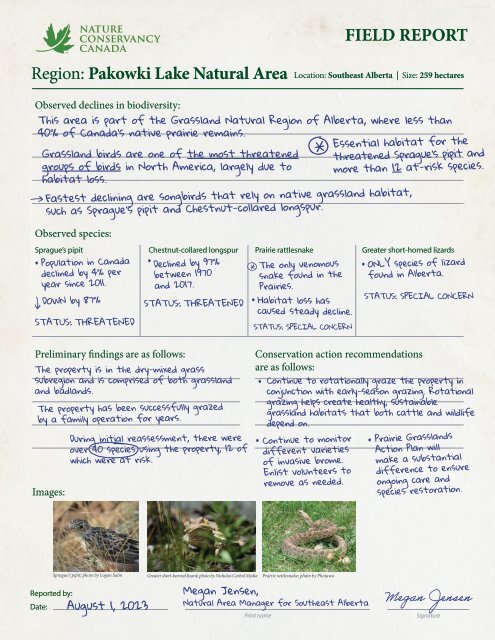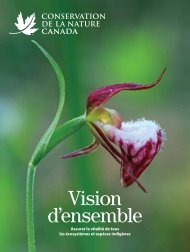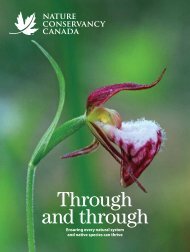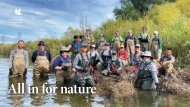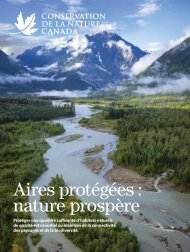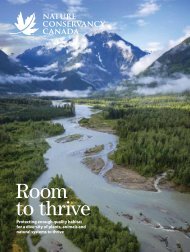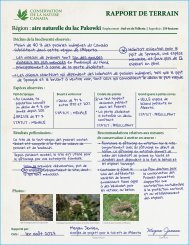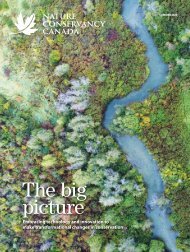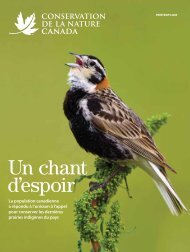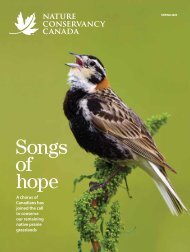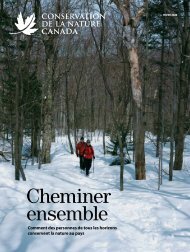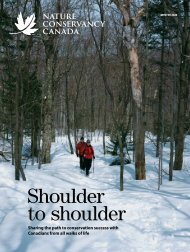You also want an ePaper? Increase the reach of your titles
YUMPU automatically turns print PDFs into web optimized ePapers that Google loves.
FIELD REPORT<br />
Region: <strong>Pakowki</strong> <strong>Lake</strong> Natural Area<br />
Location: Southeast Alberta | Size: 259 hectares<br />
Observed declines in biodiversity:<br />
This area is part of the Grassland Natural Region of Alberta, where less than<br />
40% of Canada’s native prairie remains.<br />
Grassland birds are one of the most threatened<br />
groups of birds in North America, largely due to<br />
habitat loss.<br />
Observed species:<br />
Essential habitat for the<br />
threatened Sprague’s pipit and<br />
more than 12 at-risk species.<br />
Fastest declining are songbirds that rely on native grassland habitat,<br />
such as Sprague’s pipit and Chestnut-collared longspur.<br />
Sprague’s pipit<br />
Population in Canada<br />
declined by 4% per<br />
year since 2011.<br />
DOWN by 87%<br />
STATUS: THREATENED<br />
Chestnut-collared longspur<br />
Declined by 97%<br />
between 1970<br />
and 2017.<br />
STATUS: THREATENED<br />
Prairie rattlesnake<br />
The only venomous<br />
snake found in the<br />
Prairies.<br />
Habitat loss has<br />
caused steady decline.<br />
STATUS: SPECIAL CONCERN<br />
Greater short-horned lizards<br />
ONLY species of lizard<br />
found in Alberta.<br />
STATUS: SPECIAL CONCERN<br />
Preliminary findings are as follows:<br />
The property is in the dry-mixed grass<br />
subregion and is comprised of both grassland<br />
and badlands.<br />
The property has been successfully grazed<br />
by a family operation for years.<br />
Images:<br />
During initial reassessment, there were<br />
over 40 species using the property, 12 of<br />
which were at risk.<br />
Conservation action recommendations<br />
are as follows:<br />
Continue to rotationally graze the property in<br />
conjunction with early-season grazing. Rotational<br />
grazing helps create healthy, sustainable<br />
grassland habitats that both cattle and wildlife<br />
depend on.<br />
Continue to monitor<br />
different varieties<br />
of invasive brome.<br />
Enlist volunteers to<br />
remove as needed.<br />
Prairie Grasslands<br />
Action Plan will<br />
make a substantial<br />
difference to ensure<br />
ongoing care and<br />
species restoration.<br />
Sprague’s pipit; photo by Logan Salm Greater short-horned lizard; photo by Nicholas Carbol Media Prairie rattlesnake; photo by Photawa<br />
<strong>Report</strong>ed by:<br />
Date:<br />
August 1, 2023<br />
Megan Jensen,<br />
Natural Area Manager for Southeast Alberta<br />
Print name<br />
Megan Jensen<br />
Signature


